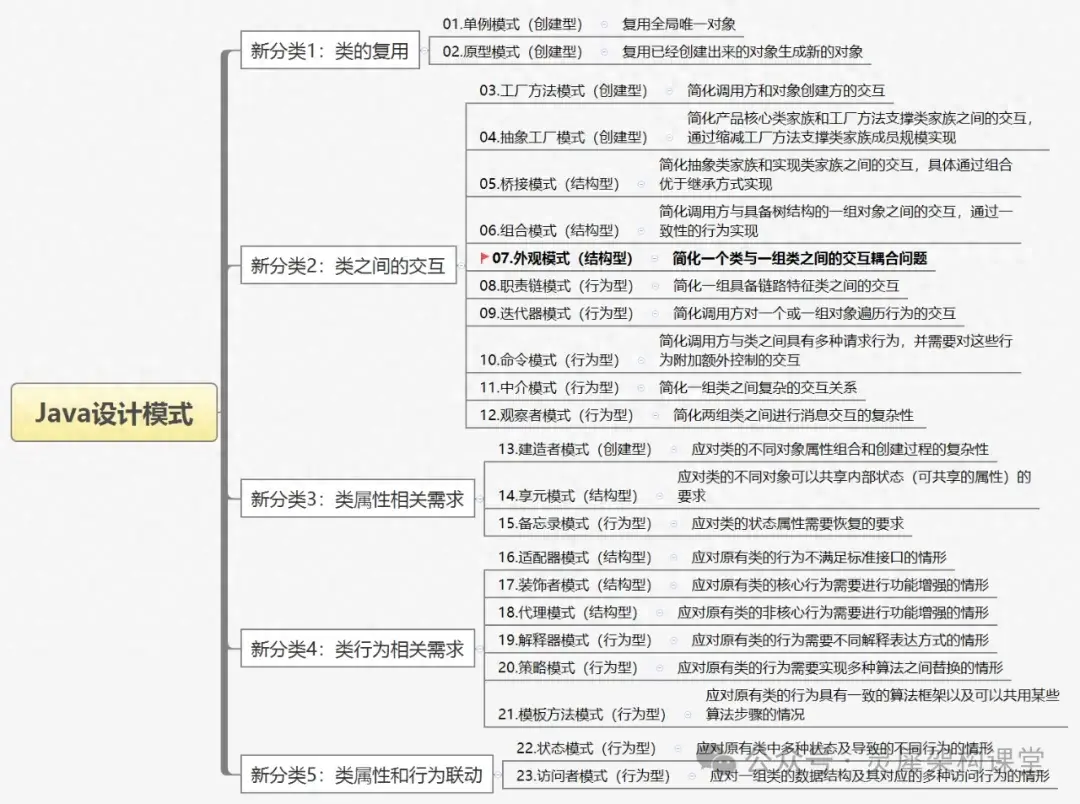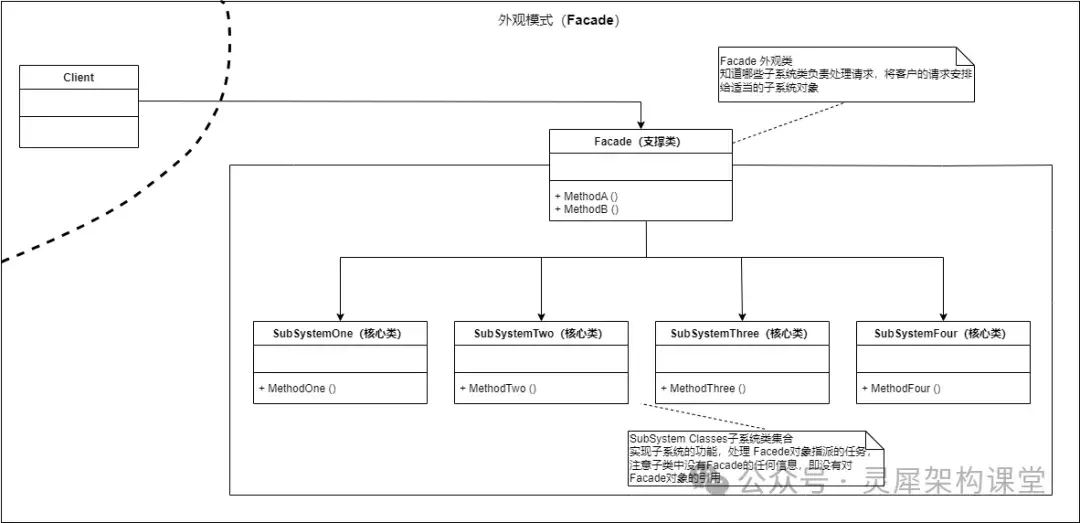本篇講解Java設計模式中的外觀模式,分為定義、模式應用前案例、結構、模式應用后案例、適用場景、模式可能存在的困惑和本質探討7個部分。
外觀模式是為子系統中的一組接口提供一個一致的界面,外觀模式定義了一個高層接口,這個接口使得這一子系統更加容易使用。
在新的分類方式中,外觀模式被劃分至類之間的交互類別中,其簡化的是一個類與一組類之間的交互耦合問題。

在外觀模式中,列舉一個電商領域的案例。先來看一下未使用外觀模式前的代碼實現。
電商領域通常包括庫存子系統、支付子系統和物流子系統,代碼如下。
public class InventorySystem {//庫存子系統 public void updateInventory(String product, int quantity) { System.out.println("Updating inventory for " + product + ": " + quantity); }}public class PaymentSystem {//支付子系統 public void processPayment(double amount) { System.out.println("Processing payment: $" + amount); }}public class ShippingSystem {//物流子系統 public void shipOrder(String address) { System.out.println("Shipping order to address: " + address); }}調用方代碼如下。
public class Client {//調用方代碼 public static void main(String[] args) { InventorySystem inventory = new InventorySystem(); PaymentSystem payment = new PaymentSystem(); ShippingSystem shipping = new ShippingSystem(); inventory.updateInventory("Computer", 1); payment.processPayment(1500); shipping.shipOrder("123 Main Street"); }}在上述代碼中,不難發現,調用方與各個子系統直接耦合,這樣主要帶來兩個問題。
一個問題是調用方需要知曉每一個子系統的細節。在某些情況下,這些子系統之間的關系也需要知曉。
另一個問題是如果子系統代碼發生變更,調用方代碼也需要受到關聯影響。

外觀模式的示例代碼如下。
public class SubSystemOne { public void MethodOne() { System.out.println("Called SubSystemComponentOne's methodOne()"); }}public class SubSystemTwo { public void MethodTwo() { System.out.println("Called SubSystemComponentTwo's MethodTwo()"); }}public class SubSystemThree { public void MethodThree() { System.out.println("Called SubSystemComponentThree's methodThree()"); }}public class SubSystemFour { public void MethodFour() { System.out.println("Called SubSystemComponentFour's MethodFour()"); }}public class Facade { private SubSystemOne componentOne; private SubSystemTwo componentTwo; private SubSystemThree componentThree; private SubSystemFour componentFour; public Facade() { componentOne = new SubSystemOne(); componentTwo = new SubSystemTwo(); componentThree = new SubSystemThree(); componentFour = new SubSystemFour(); } public void MethodA() { componentOne.MethodOne(); componentTwo.MethodTwo(); componentThree.MethodThree(); } public void MethodB() { componentTwo.MethodTwo(); componentThree.MethodThree(); componentFour.MethodFour(); }}public class Client { public static void main(String[] args) { Facade facade = new Facade(); // 客戶端只需要調用外觀類提供的接口 facade.MethodA(); facade.MethodB(); }}上述電商領域的案例,在應用外觀模式之后的代碼實現如下。
庫存子系統、支付子系統和物流子系統的代碼不變。
public class InventorySystem {//庫存子系統 public void updateInventory(String product, int quantity) { System.out.println("Updating inventory for " + product + ": " + quantity); }}public class PaymentSystem {//支付子系統 public void processPayment(double amount) { System.out.println("Processing payment: $" + amount); }}public class ShippingSystem {//物流子系統 public void shipOrder(String address) { System.out.println("Shipping order to address: " + address); }}按照外觀模式,增加了一個外觀類。
public class OrderFacade {//訂單外觀類 private final InventorySystem inventory; private final PaymentSystem payment; private final ShippingSystem shipping; public OrderFacade() { this.inventory = new InventorySystem(); this.payment= new PaymentSystem(); this.shipping= new ShippingSystem(); } //提供一個簡化方法來處理整個訂單流程 public void placeOrder(String product, int quantity,double amount,String address){ this.inventory.updateInventory(product,quantity); this.payment.processPayment(amount); this.shipping.shipOrder(address); }}最后,調用方代碼修改如下。
public class Client { public static void main(String[] args) { //使用外觀模式進行下單操作 OrderFacade facade= new OrderFacade(); facade.placeOrder("Computer", 1, 1500.00,"123 Main Street"); }}可以看到,代碼的復雜性已經挪到外觀類中實現,調用方代碼變得非常簡潔清晰。
外觀模式適用于以下場景:
1、多個子系統或接口需要通過一定的交互共同為調用方服務,如果希望子系統后續可以相對調用方獨立進行演進,可以考慮外觀模式
2、需求實現新功能時,需要依賴企業中的遺留系統的功能。由于遺留系統通常后續會安排下線。此時就不建議將遺留系統的接口直接對調用方暴露,而是在一個外觀類中封裝新增加的功能和遺留系統功能
困惑1:外觀模式定義中提到的“界面”,具體是什么含義?
在外觀模式中,多個子系統屬于一個大的系統。界面可以理解為這個大系統對外暴露的契約接口。調用方只能通過界面來與系統進行交互。
對于一個系統來講,對外暴露清晰簡潔的接口是非常有必要的。這不僅可以節省與調用方的溝通成本,也可以與調用方相對解耦,以便后續獨立進行演進。
在系統建設初期,和調用方會制定契約接口。但是隨著系統功能越來越多,經常會發現調用方需要依賴的接口越來越多,此時就可以將相互有關系的接口,再通過外觀類這一層進行再封裝,始終保持對外的簡潔性。
此外,在外觀模式下,外觀類通常并不新增功能,僅僅是封裝已有多個子系統的交互關系。
本文鏈接:http://www.www897cc.com/showinfo-26-87982-0.html一文徹底搞明白外觀模式
聲明:本網頁內容旨在傳播知識,若有侵權等問題請及時與本網聯系,我們將在第一時間刪除處理。郵件:2376512515@qq.com
上一篇: 優化代碼性能:C#中輕松測量執行時間